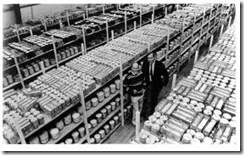Despite Hollywood’s glamorization of sunken treasure ships, few galleons sank during the lucrative China Trade era. But on January 3, 1752, the Dutch East India Company (VOC) ship Geldermalsen went down near the straights of Malacca en route from Macao, China to its home in Rotterdam, The Netherlands.
At sunset a reef tore the Geldermalsen’s keel apart. The surrounding waters were shark infested. Most sailors then couldn’t swim. Miraculously, several crew members made it to shore. But piracy was rampant in those waters, and the survivors were strangers in a strange land. So even more miraculously, they evaded capture and returned home.
Their trial began two months later. It was VOC policy to charge any crew who abandoned their ship with “gross treason.” A guilty verdict meant death. Fortunately for the hapless crew, they were let off.
Fortunately for us, their ship was discovered 233 years later with most of the 150,000 pieces of porcelain on board intact. Buried under a blanket of tea. When combined with the VOC’s scrupulous archive of invoices, this find offers a priceless record of 17th and 18th century China Trade porcelain.
The VOC was one of the first international trade cartels. As such, they cared only for profit (ie: volume vs. fancy, difficult to pack items). Huge returns were made on teacups alone. Ships could carry over 100,000 teacups in a single load, with room to spare for other orders. Teacups could be densely packed because they didn’t have handles. Only chocolate cups did until around 1750.
To fill these massive orders, some factories in Jingdezhen were entirely geared toward European designs. Enameling workshops popped up around European trading posts in Canton and Macao to quickly decorate plain porcelain – a Chinese version of cheap Chinese knock-offs of up-scale Chinese products.
East Indiaman sailors were allowed small personal purchases of more elaborate work on the side, in quantities corresponding to rank, as compensation for relatively poor wages.
During the Trade’s heyday, porcelain generally functioned as the ship’s ballast. Above that went bales of tea. The best tea went in lead-sealed crates to preserve freshness. (During America’s China craze, “tea chest lead” was a prized source of glaze material for redware potters.)
The Geldermalsen’s load was typical: simple teacups, bowls, plates, etc. But hardly any teapots. The salvage crew didn’t mind, though. After sifting through tons of decayed tea to get to the porcelain, most said they’d never drink tea again.
 Recovered cargo from the Geldermalsen.
Recovered cargo from the Geldermalsen.
Reading:
The Geldermalsen, History and Porcelain. CJA Jörg. Kemper Publishers/Groningen, The Netherlands. 1986.
China-Trade Porcelain. John Goldsmith Phillips. Harvard University Press/Cambridge, MA. 1956.